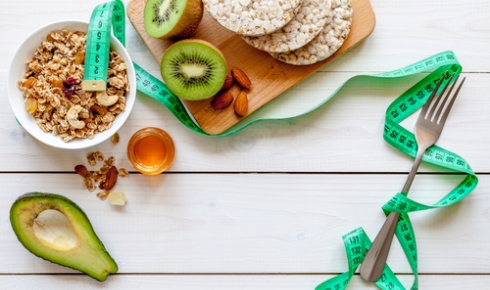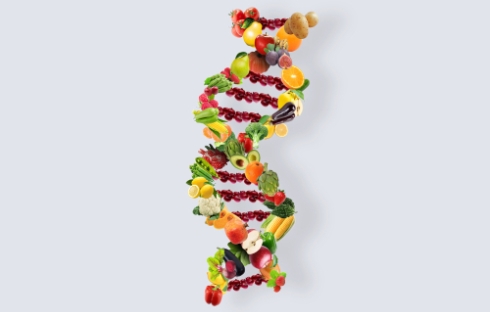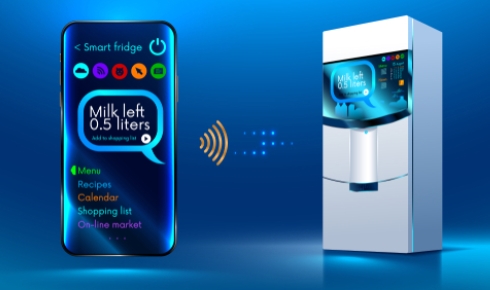Making it personal

Public health advice, especially on what to eat, often seems contradictory or hard to follow. Sam Lane and Siân Astley say the answer is personalised dietary advice based on based on a range of information and data from smart devices
The Biologist 65(6) p20-23
We’ve read the headlines, skimmed the columns and watched the videos, yet we are none the wiser about what we should actually be doing to stay healthy. Rather than there being a shortage of health advice, there is too much for anyone to sensibly digest, particularly when it comes to diet.
Eating is so much more than just a means to be healthy[1] so dietitians and registered nutritionists continue to be crowded out of the market by celebrities, bloggers and YouTube stars, with their ‘10 foods for fat loss’ and other claims. While it is positive that people are increasingly engaged with what they eat and how it affects their longer-term health, it’s hard not to be swept away by the latest fad. Other people are overwhelmed, resigned to failure or not listening because public health messages are confusing, apparently contradictory or just not realistic for them.
Fortunately, a quiet revolution has been going on in diet, nutrition and health research since around 2000. Researchers have recognised that the one-size-fits-all approach to public health is not working, either individually or at the population level. In medicine, a better understanding of the interactions among genes and healthy and unhealthy phenotypes – and improved technologies that enable genomic research and big data analysis – are changing how we treat disease. Personalised and precision medicine are facilitating therapies tailored for individual patients or patient types, and earlier diagnoses and optimal treatments are improving healthcare and lowering costs.
This approach is also helping shift the old paradigm of ‘eat less, move more’ to something more tailored. If not always for the individual, health advice can at least be tailored to population groups facing the same key issues or questions, known as precision advice.
Ultimately, the aim is to combine healthy behaviours and personal goals in such a way that small changes are adopted gradually and become good habits, leading to better health. By including personal goals, our need for gratification (that is, seeing results from our efforts) is met in a more tangible form while the bigger issues, which take time or offer slower feedback, take care of themselves.
What does personalised nutrition look like?
While there is no regulated definition of personalised nutrition, we can consider personalised in this context as information based on characteristics, such as genotype or phenotype, which is used to develop nutritional advice or products[2] to support individuals or groups in achieving eating patterns and/or behaviours that are beneficial to health[3].
Personalised nutrition advice can be delivered via government or private healthcare, in partnership with organisations (weight-management clubs, gyms or informal groups), one to one through an independent practitioner, or independently using a health or wellbeing app. Typically, the information sought from individuals depends on the extent of personalisation and desired goals. Understanding how this data relates to individuals is what enables personalised nutrition to be more effective and, concomitantly, reduce the risk of non-communicable diseases[4].
Of course, dietitians and registered nutritionists have been providing increasingly personalised advice for decades, but it is not uncommon for nutrition professionals to encounter different outcomes using the same intervention and management strategies[5]. An overwhelming body of evidence, known as nutrigenetics, has demonstrated that genetics has a role in how the body responds to diet and lifestyle modification and individual nutritional requirements[6].
These developments in understanding the effect of nutrigenetics (genes in response to nutrients) and nutrigenomics (the effect of diet, nutrients or bioactive compounds on the genome) mean personalised nutrition advice can be better than generic approaches. As we better understand the relationships between foods, nutrients (and non-nutrients such as polyphenols) and health, this information can make health advice more appropriate to individuals, and not just for diseases and metabolic syndromes caused by single gene mutations[5].

Nutrigenetics looks at gene-food-disease interactions and could help inform a truly personalised dietary advice service in the future. A well-described example is the relationship between food-based folates and the gene for MTHFR (5,10-methylenetetra-hydrofolate reductase), which has a role in processing amino acids.
There is a common mutation in the gene for MTHFR that produces a less-efficient form of the enzyme. Those with two copies of the unstable version and low dietary folate accumulate homocysteine and have lower levels of methionine, which increases their risk of vascular disease and premature cognitive decline.
When supplemented with folic acid (or with increased intake of folate from food sources), these individuals quickly metabolise the excess homocysteine, restoring their methionine to normal levels and lowering their risk of vascular disease and premature cognitive decline. Currently, we are aware of about 20 genes that have variants that appear to confer a significant disadvantage that may be overcome with dietary modification.
Personalised advice can be used to tackle weight loss or gain, and manage type 2 diabetes, but also reduce the risk of non-communicable diseases in the wider population based on phenotypic characteristics such as raised cholesterol and central adiposity. While dietary factors contribute to cardiovascular disease (CVD), type 2 diabetes and some cancers, public health campaigns have had limited success[2] in reversing these trends, and new or better understanding of the science has led to apparently conflicting advice (e.g. saturated fat consumption and risk of CVD[7]).
In contrast, personalising advice has been shown to be more effective in improving eating habits. A study among European adults given personalised nutrition advice online produced larger and more appropriate changes in dietary behaviours than a conventional approach[8] although there is still some debate as to whether the personalised advice or the personalised delivery has the greatest influence.
Technology for personalisation
Currently, the kinds of services envisaged by researchers are not available through most European government healthcare systems. There are, however, millions of health and wellbeing apps, thousands of which are generating revenue and data offering support for weight loss, diabetes management and so on without any underlying scientific evidence of benefit. At a 2017 food industry conference, delegates were asked which three trends in the nutrition industry were most important. Over a third of respondents believed personalised nutrition to be a key trend, due to increasing interest in consumer choice and dietary guidelines, and developments in wearable technologies and genetic testing.
Given there is a market appetite for personalised nutrition advice and research supporting its efficacy, how might the new paradigm of personalised nutrition be realised, especially among hard-to-reach and disaffected groups? Auspiciously, the technological advances that made personalised nutrition scientifically valid can also make delivery a reality. More data than ever is being collected from a range of sources (Bluetooth/internet-enabled bathroom scales, fridges, loyalty cards, Amazon Alexa) and devices (smart watches and phones, Fitbits, cameras), and this information and supporting metadata are of increasingly higher quality and available in real time.
 Internet-enabled devices such as fitbits and smart fridges could collect real-time data that is then used to inform health advice and food purchases.
Internet-enabled devices such as fitbits and smart fridges could collect real-time data that is then used to inform health advice and food purchases.These resources also allow individuals to engage less with the actual collection of data, with information gathered and processed automatically, rather than, say, manually writing up food diaries or recording changes in weight. It is well established that individuals omit or elaborate details of their diet and lifestyle, but when information can be collected and processed automatically, we are much less able to cheat, which in turn means the advice or strategy given is more likely to be effective. Advice can be offered or behaviours nudged automatically, without agonising over previous failures – for example, shopping is ordered and delivered based on the person’s previous food consumption, or recent outcomes such as whether weight has been lost or gained.
There are now a number of EU-funded initiatives drawing together results from previous research and development projects such as Food4Me4[8] to deliver personalised nutrition data, knowledge, tools and services in ways that will encourage commercial exploitation. Quisper (quisper.eu) is a digital platform supporting personalised nutrition services in Europe and managed by a non-profit organisation in Belgium that we, the authors, have worked on. Its services are designed for IT developers delivering health and wellbeing apps, as well as healthcare providers, societal organisations and professionals providing personalised nutrition advice.
Furthermore, apps providing individuals with evidence-based personalised advice are being integrated with Quisper to help individuals and organisations wanting to deliver only personalised nutrition services. One example is eNutri from the University of Reading, which uses validated food frequency questionnaires and diet quality scores to generate personalised advice.9
Personalisation and privacy
An approach drawing data from a wide range of interconnected sources, however, does create ethical issues, not least ownership of the data and use of data by third parties. The introduction of the General Data Protection Regulation means access and control of personal data are coming under closer scrutiny. Consumers also need to be more proactive and aware that their data is valuable and their responsibility, and companies need to be more transparent. Most of us are guilty of scrolling through unintelligible legal terms and conditions in search of the agree box, never realising our data is being exploited for commercial gain.
After recent scandals about the misuse of personal data, organisations using personalised data need to build trust to grow consumer acceptance and uptake. Thus, it is important that personalised nutrition complies with the FAIR data principles[10] with respect to research data, and services create and maintain a culture that is legal, decent, honest and trustworthy. For personalised nutrition to achieve its potential, consumers need to know they are getting scientifically robust advice and be able to distinguish such providers from those delivering general public health advice, or those that just look pretty and are fun to use.
In the absence of a legal definition, a framework to explain personalised nutrition has been developed whereby: “advice and information should be based on clear evidence of validity grounded in a careful and defensible interpretation of outcomes from nutrigenetic research studies to avoid misuse and protect the public"[9]. Given the drive towards more evidence-based advice about diet and health, from both policymakers and by public demand, the development of robust frameworks[11] and legal protection – for example, through trade description legislation – will be fundamental to the success of personalised nutrition and retaining the trust of consumers and healthcare professionals and allied practitioners such as dietitians.
The need for personalised nutrition is increasingly obvious, and its application is becoming more realistic and robust, but the hope must be that data-driven diets will not be just another fad.
Dr Siân Astley is a senior researcher and communications manager at the European Food Information Resource. Sam Lane AMRSB is a communications analyst at the European Parliament, formerly a policy and communications associate at the European Food Information Resource. They are both currently beneficiaries on the EIT Food-funded project Quisper (ID 18064).
1) Higgs, S. & Thomas, J. Social influences on eating. Current Opinion in Behavioral Sciences 9, 1-6 (2016).
2) Ordovas, J. et al. Personalised nutrition and health; BMJ 361 k2173 (2018).
3) Gibney, M. et al. Personalized nutrition: paving the way to better population health. In: Good nutrition: perspectives for the 21st century. Karger Publishers, 235-48.
4) Gibney, E. Personalised Nutrition. The Journal of the Institute of Food and Technology 2017.
5) Murgia, C. & Adamski, M. M. Translation of nutritional genomics into nutrition practice: The Next Step Nutrients 9(4), 366 (2017)
6) Fenech, M. et al. Nutrigenetics and nutrigenomics: Viewpoints on the current status and applications in nutrition research and practice. J. Nutrigenet. Nutr. 4 69–89 (2011).
7) de Souza, R. J. et al. Intake of saturated and trans unsaturated fatty acids and risk of all-cause mortality, cardiovascular disease, and type 2 diabetes: systematic review and meta-analysis of observational studies. BMJ 351 h3978 (2015).
8) Celis-Morales, C. et al. Effect of personalized nutrition on health-related behaviour change: evidence from the Food4Me European randomized controlled trial. International Journal of Epidemiology 46(2), 578–588 (2017).
9) Franco, R. Z. et al. A web-based graphical food frequency assessment system: design, development and usability metrics. JMIR Human Factors 4(2) (2017).
10) The FAIR Guiding Principles for scientific data management and stewardship. Scientific Data 3, Article number: 160018 (2016).
11) Grimaldi, K. et al. Proposed guidelines to evaluate scientific validity and evidence for genotype-based dietary advice. Genes & Nutrition 12 (2017).


